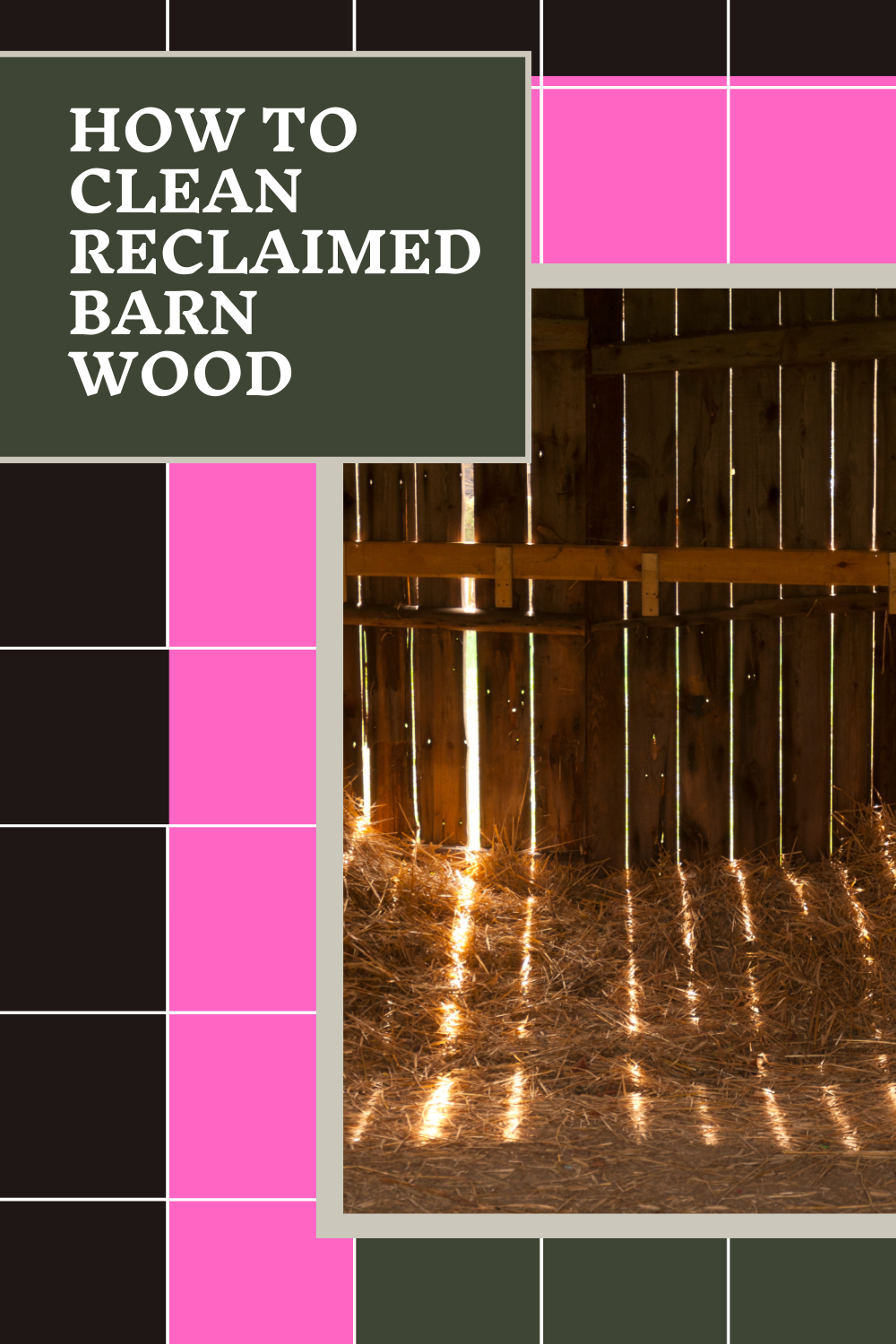Finding the perfect reclaimed barn wood for your project is only half the battle. The real challenge begins when you need to clean it. Old barn wood often comes with dirt, grime, and sometimes even a bit of mold or mildew.
While the wood’s age and rustic imperfections are part of its appeal, cleaning it properly is essential for both aesthetics and longevity.
In this guide, I’m going to walk you through the process of cleaning reclaimed barn wood. From tools to techniques, I’ll cover everything you need to know to restore that beautiful, weathered charm while ensuring the wood stays in great condition.
Why Should You Clean Reclaimed Barn Wood?
Before jumping into the cleaning process, let me ask: Have you ever thought about why it’s important to clean reclaimed barn wood? If you’re like many, you might think that because the wood is old, it should be left alone, imperfections and all. While it’s true that the history of reclaimed wood is part of its charm, cleaning the wood can help remove:
- Dirt and Grime: Years of exposure to the elements can leave dust and dirt embedded in the wood, making it look dull.
- Mold and Mildew: If the barn wood was exposed to moisture or humidity, it could harbor mold or mildew, which isn’t just unsightly but can also be harmful to your health.
- Old Finish or Paint: Many pieces of reclaimed wood may have layers of old paint, wax, or finishes that can obscure the natural beauty of the wood.
Cleaning the wood properly enhances its appeal, restores its natural beauty, and ensures it’s safe to use in your home.
Tools and Materials for Cleaning Reclaimed Barn Wood
Before diving into the cleaning process, let’s start by gathering the necessary tools and materials. Here’s what you’ll need:
Essential Tools:
- Wire Brush: Perfect for scrubbing away loose dirt, old paint, or mold on the surface.
- Sandpaper or Power Sander: To remove deeper stains or imperfections.
- Soft Cloths or Rags: For applying cleaning solutions and wiping down the wood.
- Bucket: For mixing cleaning solutions and holding water.
- Protective Gloves: Barn wood may have sharp nails or edges, so gloves are a must for safety.
Cleaning Solutions:
- Dish Soap: Gentle and effective for cleaning dirt and grime.
- White Vinegar and Water: This natural cleaner works wonders on mold and mildew.
- Wood Cleaner: If the wood is particularly dirty, a wood-specific cleaner might be the best option.
- Mineral Spirits: Great for removing oil-based finishes and stubborn dirt.
Optional:
- Bleach: If mold is severe, bleach can help disinfect, but be careful as it can lighten the wood too much.
- Wood Conditioner: After cleaning, a good wood conditioner will help restore moisture and prevent cracking.
Step-by-Step Cleaning Process
Now that we’ve gathered our materials, it’s time to get started with cleaning the reclaimed barn wood. Here’s a simple, step-by-step guide:
- Assess the Wood
Start by examining the wood. Are there visible stains, mold, or paint? Does it look like it’s been exposed to weather or neglect? This will guide your cleaning process, especially if deeper cleaning methods (like sanding or bleaching) are needed. - Remove Loose Dirt
Use a wire brush to remove any loose dirt, cobwebs, or small debris stuck in the wood grain. Brush in the direction of the grain to avoid scratching the surface. - Clean with Soap and Water
In a bucket, mix warm water and a few drops of mild dish soap. Using a soft cloth or sponge, gently wipe down the surface. Be careful not to oversaturate the wood, as excessive moisture can cause the wood to warp. - Treat Stubborn Mold or Mildew
If you spot mold or mildew, mix equal parts of white vinegar and water in a spray bottle and apply it to the affected areas. Let it sit for 10-15 minutes before wiping it off with a clean cloth. This should kill any spores and prevent the mold from coming back. - Scrape Off Old Paint or Stains
If the wood has old paint or stubborn stains, you may need to use a sanding block or a power sander. Start with coarse-grit sandpaper and move to finer grits for a smooth finish. - Rinse and Dry
Once the wood is cleaned, use a damp cloth to wipe away any remaining cleaning solution. Then, let the wood air dry completely before proceeding to the next steps.
Common Mistakes to Avoid
While cleaning reclaimed barn wood seems straightforward, there are some common mistakes that many DIYers make. Here’s what to avoid:
- Using Too Much Water
Excessive water can warp or discolor reclaimed barn wood. Always use a damp cloth, not a soaking wet one, and make sure the wood is fully dry before using it. - Over-Scrubbing
Over-scrubbing with a wire brush or sanding too aggressively can damage the wood. Be gentle, especially when dealing with delicate wood grains. - Skipping Mold Treatment
Mold can lead to more serious issues like wood rot and health problems. Always treat any mold or mildew as soon as you notice it to prevent it from spreading. - Not Sealing the Wood
After cleaning, many people forget to apply a wood conditioner or sealer. This is crucial, as it helps protect the wood from future damage.
Maintenance Tips for Reclaimed Barn Wood
After cleaning your reclaimed barn wood, you’ll want to maintain it so it stays looking beautiful for years to come. Here are a few tips:
- Regular Dusting
Use a soft, dry cloth to dust the wood regularly. This will help prevent dirt from building up again. - Avoid Direct Sunlight
While reclaimed barn wood looks fantastic, prolonged exposure to direct sunlight can cause it to fade. Try to place your wood pieces in areas where they won’t be hit by harsh sun rays. - Use Wood Polishes Sparingly
If you want to add some shine, use a wood polish designed for antique or reclaimed wood. Just don’t overdo it, as too much polish can build up over time and affect the wood’s natural finish. - Apply a Fresh Coat of Sealant
Every few years, you might want to reapply a wood sealer to protect the wood from moisture and wear.
Table: Comparing Cleaning Solutions for Reclaimed Barn Wood
| Solution | Best For | Application |
| Dish Soap and Water | Basic cleaning of dirt and grime | Use a soft cloth or sponge for gentle cleaning |
| White Vinegar and Water | Mold and mildew removal | Spray on affected areas and wipe after 10-15 minutes |
| Mineral Spirits | Removing oil-based finishes and stubborn stains | Apply to a cloth and gently rub off stains |
| Bleach (Optional) | Severe mold or discoloration | Use cautiously; mix with water and apply in small amounts |
| Wood Conditioner | Post-cleaning care | Apply a thin coat to restore moisture and prevent cracks |
Conclusion
Reclaimed barn wood is a beautiful addition to any space, but it requires care and attention to keep it looking its best. By following the steps outlined above, you can clean and maintain your reclaimed wood without compromising its rustic charm.
Remember, the key to successful cleaning is using the right tools, being gentle with the wood, and treating any mold or mildew promptly. Also, don’t forget to maintain your wood with regular dusting and occasional re-sealing. With these tips, you’ll be able to enjoy your reclaimed barn wood’s natural beauty for years to come. So go ahead and clean up that gorgeous piece of history, and make it shine in your home!



